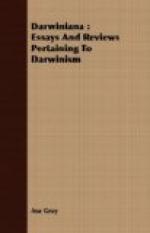That the tubes or pitchers of the Southern species are equally attractive and fatal to flies is well known. Indeed, they are said to be taken into houses and used as fly-traps. There is no perceptible odor to draw insects, except what arises from the decomposition of macerated victims; nor is any kind of lure to be detected at the mouth of the pitcher of the common purple-flowered species. Some incredulity was therefore natural when it was stated by a Carolinian correspondent (Mr. B.F. Grady) that in the long-leaved, yellow-flowered species the lid just above the mouth of the tubular pitcher habitually secretes drops of a sweet and viscid liquid, which attracts flies and apparently intoxicates them, since those that sip it soon become unsteady in gait and mostly fall irretrievably into the well beneath. But upon cultivating plants of this species, obtained for the purpose, the existence of this lure was abundantly verified; and, although we cannot vouch for its inebriating quality, we can no longer regard it as unlikely.
No sooner was it thus ascertained that at least one species of Sarracenia allures flies to their ruin than it began to appear that—just as in the case of Drosera—most of this was a mere revival of obsolete knowledge. The “insect-destroying process” was known and well described sixty years ago, the part played by the sweet exudation indicated, and even the intoxication perhaps hinted at, although evidently little thought of in those ante-temperance days. Dr. James Macbride, of South Carolina—the early associate of Elliott in his “Botany of South Carolina and Georgia,” and to whose death, at the age of thirty-three, cutting short a life of remarkable promise, the latter touchingly alludes in the preface to his second volume—sent to Sir James Edward Smith an account of his observations upon this subject, made in 1810 and the following years. This was read to the Linnaean Society in 1815, and published in the twelfth volume of its “Transactions.” From this forgotten paper (to which attention has lately been recalled) we cull the following extracts, premising that the observations mostly relate to a third species, Sarracenia adunca, alias variolaris, which is said to be the most efficient fly-catcher of the kind:
“If, in the months of May, June, or July, when the leaves of those plants perform their extraordinary functions in the greatest perfection, some of them be removed to a house and fixed in an erect position, it will soon be perceived that flies are attracted by them. These insects immediately approach the fauces of the leaves, and, leaning over their edges, appear to sip with eagerness something from their internal surfaces. In this position they linger; but at length, allured as it would seem by the pleasure of taste, they enter the tubes. The fly which has thus changed its situation will be seen to stand unsteadily; it totters for a few seconds, slips, and falls to the bottom of the tube, where it is either




